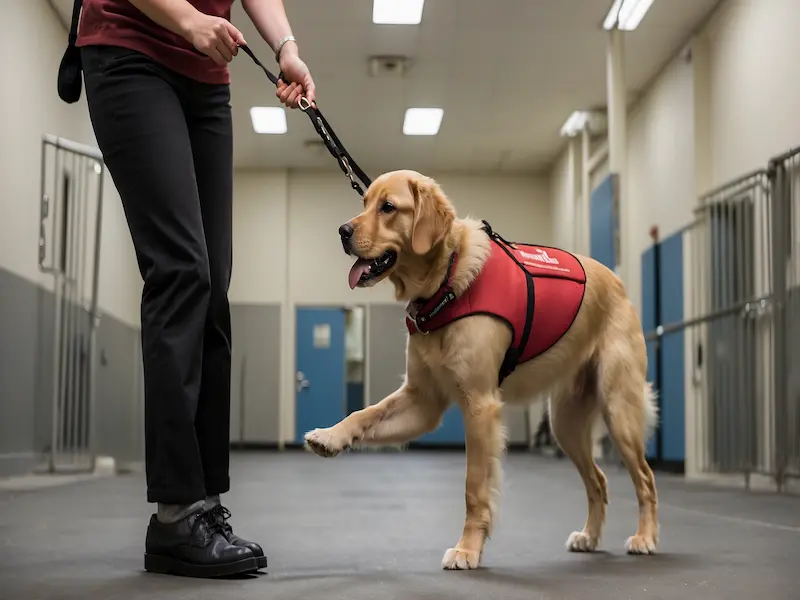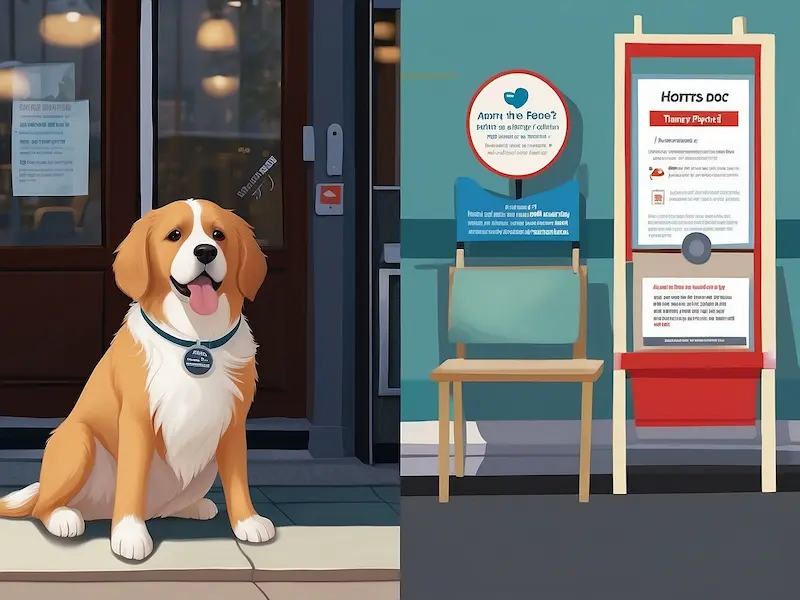Public access training is a crucial component of preparing therapy and emotional support dogs (ESDs) to behave appropriately in public spaces. While therapy dogs visit hospitals, schools, and nursing homes to provide comfort, and emotional support dogs assist individuals with mental health conditions, both require structured training to ensure calm, predictable, and well-mannered behavior.
This guide explores essential public access training steps, behavior expectations, and legal considerations for therapy and emotional support dogs.
Understanding Public Access Training

What Is Public Access Training?
Public access training teaches therapy and emotional support dogs how to behave appropriately in various public environments. This training ensures they remain calm, obedient, and focused on their role despite distractions.
Difference Between Therapy Dogs and Emotional Support Dogs in Public Access
- Therapy Dogs: Visit facilities like hospitals and schools to provide comfort. They require permission from institutions but do not have public access rights under the Americans with Disabilities Act (ADA).
- Emotional Support Dogs (ESDs): Provide comfort to individuals with mental health conditions. They are protected under the Fair Housing Act (FHA) for housing accommodations but do not have ADA public access rights like service dogs.
Since neither therapy dogs nor ESDs have automatic public access rights, they must be trained to behave appropriately when allowed in public settings.
Essential Public Access Training Steps
Basic Obedience and Leash Control

Before public training, therapy and emotional support dogs must master fundamental obedience commands:
- Sit – Remain seated until released.
- Stay – Hold position despite distractions.
- Heel – Walk calmly next to the handler.
- Come – Return immediately when called.
- Leave it – Ignore distractions, food, and objects.
Using positive reinforcement, such as treats and praise, strengthens obedience training and enhances reliability in public environments.
Exposure to Public Environments
Gradual exposure helps dogs adjust to various public spaces. Recommended training environments include:
- Shopping centers and stores – Acclimation to crowds and noise.
- Public transportation – Familiarization with buses, trains, and elevators.
- Healthcare settings – Exposure to wheelchairs, hospital sounds, and medical equipment.
- Outdoor events and parks – Training for controlled behavior around distractions.
Short, structured visits help dogs become comfortable in different surroundings while reinforcing calm behavior.
Ignoring Distractions and Remaining Focused

Public access training involves teaching therapy and emotional support dogs to ignore common distractions, such as:
- Food on the ground
- Other animals
- Loud noises (sirens, horns, alarms)
- Excited children or approaching strangers
Techniques to reinforce focus include:
- Practicing controlled walking near distractions.
- Using verbal cues like “focus” to maintain attention.
- Rewarding calm behavior with treats and praise.
Proper Public Behavior and Manners
Public access-trained dogs must exhibit exceptional manners, including:
- Walking politely on a leash – No pulling or excessive sniffing.
- No jumping on people or furniture – Respecting personal space.
- Settling quietly in place – Staying relaxed in busy environments.
- Ignoring petting unless permitted – Only engaging when directed by the handler.
Consistent reinforcement of these behaviors ensures the dog remains well-mannered and accepted in public spaces.
Challenges and Solutions in Public Access Training
Managing Anxiety in Public Spaces
Some therapy and emotional support dogs may experience anxiety in public. Solutions include:
- Gradual exposure with short training sessions.
- Encouraging calmness through deep pressure therapy.
- Using calming aids, such as vests or chew toys, to reduce stress.
Preventing Overexcitement
Some dogs may become overly excited when interacting with people. Strategies to manage this include:
- Reinforcing calm greetings (e.g., sitting before petting).
- Redirecting energy with commands like “look at me.”
- Taking breaks in quieter areas to reduce stimulation.
Handling Unexpected Situations
Public spaces present unpredictable scenarios. Handlers should train for:
- Encounters with aggressive animals – Practicing “leave it” and safe distancing.
- Emergency sirens or loud noises – Teaching dogs to remain composed.
- Navigating crowded spaces – Reinforcing focus commands.
Training for these challenges ensures the dog remains under control in all public environments.
Legal Considerations for Public Access

Public Access Rights of Therapy and Emotional Support Dogs
- Therapy Dogs: Only allowed in public spaces when invited (e.g., hospitals, nursing homes, schools). They do not have legal public access rights under the ADA.
- Emotional Support Dogs: Have housing protections under the FHA but do not have public access rights like service dogs.
Facility-Specific Rules
Businesses and institutions may have different rules regarding therapy and emotional support dogs. Before visiting:
- Obtain permission from facility administrators.
- Follow organization-specific guidelines on behavior and attire (e.g., therapy dog vests).
Understanding these regulations ensures compliance and smooth interactions with the public.
Conclusion
Public access training is essential for therapy and emotional support dogs to behave appropriately in public settings. By reinforcing obedience, socialization, and proper behavior, handlers can ensure their dogs remain calm, focused, and well-mannered. Addressing common challenges, such as anxiety and overexcitement, further enhances their effectiveness in providing emotional support.
For those seeking additional guidance, professional trainers and therapy dog organizations offer structured programs to optimize public access training.
Frequently Asked Questions (Q&A Section)
Can emotional support dogs go into public places like restaurants or stores?
No, emotional support dogs do not have public access rights under the ADA. They are only allowed in pet-friendly establishments unless specific exceptions apply.
How long does it take to complete public access training?
Public access training typically takes 6–12 months, depending on the dog’s temperament, prior training, and exposure to different environments.
Do therapy dogs need to be certified for public access?
While certification is not legally required, most hospitals, schools, and nursing homes require therapy dogs to be certified by recognized organizations such as Therapy Dogs International (TDI) or Alliance of Therapy Dogs (ATD).
What behaviors disqualify a dog from public access training?
Behaviors that may disqualify a dog include:
- Excessive barking or whining
- Aggression or reactivity toward people or animals
- Fearfulness or inability to handle stress
Dogs displaying these behaviors may need additional training before progressing to public settings.
How can I train my emotional support dog for calm behavior in public?
To encourage calm behavior:
- Start training in quiet environments and gradually introduce distractions.
- Use positive reinforcement to reward focus and relaxation.
- Practice regular exposure to new people and places to build confidence.
By following these guidelines, therapy and emotional support dogs can navigate public spaces confidently, providing valuable comfort and companionship to those who need them.

